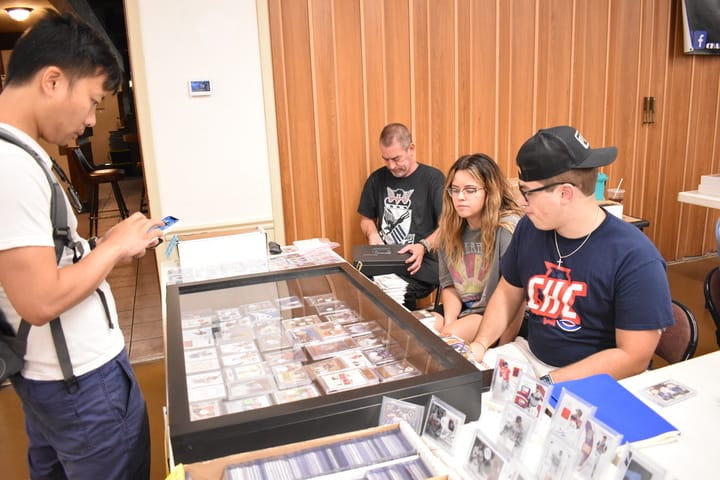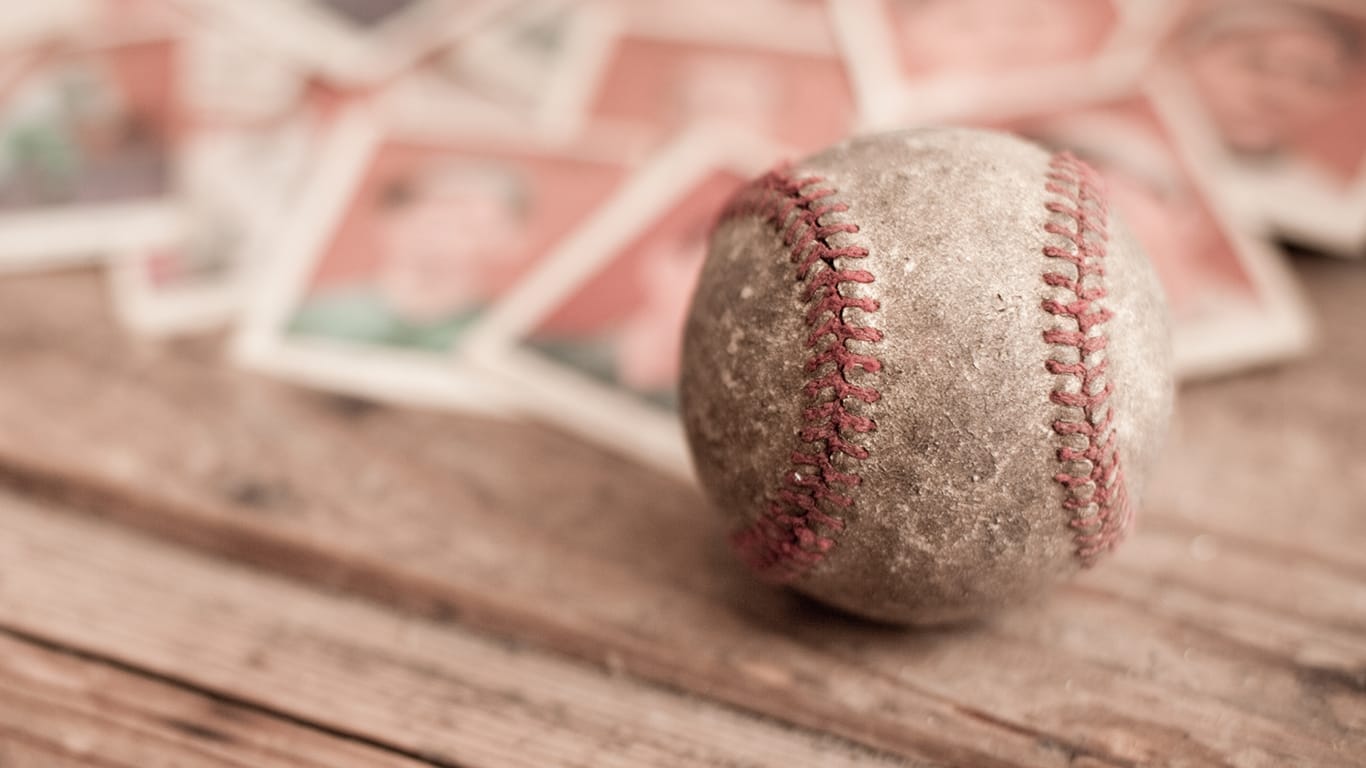As the blazing Arizona sun signals the start of spring, a different kind of migration takes place in the Valley. While 15 Major League Baseball teams flock to the Phoenix area for the Cactus League, a separate breed of enthusiasts also descends on the region. These are the devoted baseball card collectors and traders, eager to capitalize on the annual surge of interest in baseball card collecting fueled by the return of America’s pastime.
MORE NEWS: Diamondbacks announce $1 million charitable gift to Banner Sports Medicine
With all the Cactus League stadiums conveniently located within a 45-minute radius, offering fans access to their favorite players, the spring training period presents a unique opportunity for card collectors. As professional athletes stretch their muscles and tune their skills, these hobbyists are already engaged in a different kind of warm-up – one that involves collecting cardboard treasures.
Jack Georgie is a part-owner of the AMS Sports Card shop in Tempe. AMS specializes in all sports cards, including football, basketball, baseball and hockey. However, as the cold melts away, Georgie brings out the baseball cards to feature for fans.
“When you have spring training, you get people from 15 different cities coming in,” Georgie said. “You don’t know what you’re going to get or who you’re going to find in the shop.”
This year, the Cactus League amassed over 1.6 million attendees across the league’s 216 games. Spring training is one of the jewels in Arizona’s growing tourism industry, and Arizona Sports card shops are uniquely positioned to take advantage. Instead of being limited to Arizona’s sports teams, card stores cater and sell to buyers from across the world as fans search for their team’s best players on shelves.

The pandemic effect and shift to card shows
The annual fervor for the trading card market has been a recent trend, and according to KingsResearch, the sports trading cards global market was valued at approximately $9 billion in 2022, with projected growth up to an estimated $20 billion by 2030.
SkyQuest, a data analysis company that conducted a study on the global trading card market, projects even larger growth for the card industry. By 2031, SkyQuest projects the card market to be valued at $39.53 billion, with a compound annual growth rate of 18.5% from 2024 to 2031.
The COVID-19 pandemic sparked a rapid increase in interest in sports cards. Stuck inside their houses, people turned their attention toward old hobbies and knocked the dust off binders and shoeboxes filled with cards.
The sports card market on eBay, the primary website used to buy and sell cards, grew by over 150%, with over four million more cards sold in 2020 than in 2019, according to marketdecipher.com. Most card vendors, however, don’t believe the market will ever return to those 2020 highs.
“It was an explosion of wealth like we had never seen before,” card vendor Tyler Santos said. “People had nothing to do and decided to spend all their money on cards.”
Most cards posted in 2020 would be gone within minutes, making it more difficult to consistently get cards and created oversaturation within the industry. Now, most serious investors spend their time at large card shows to purchase their inventory.
“There are so many more people that are buying right now at an absurd clip that it is getting hard to compete,” Santos said. “That’s why buying at the card shows is so much better. You have a lot of guys that don’t really do social media there, so it’s a fresh product. It’s like fresh powder when you go snowboarding.”
Card shows have been around for a while. Like any rare and coveted collectible, events are held where people converge to negotiate, swap and acquire the next jewel for their collection. However, instead of small local shows hosted at local card shops, the events are moving to much larger scales.
The Arizona State Card Show: Spring Training Spectacular held its seventh event this year.
“It’s about advertising out at all the spring trainings,” said Cole McAuliff, owner of Collectibles on College, the company that runs the annual card show. “It seemed to work well for us, growing that tie between the card show and spring training.
“We’ve heard from people who have been to our show before and are excited to come again, making it a part of their Spring Training vacation.”
The Arizona State Card Show was held at the Phoenix Convention Center from March 15-17, overlapping the Cactus League season. Over 450 tables lined the venue, attracting a record 4,500 attendees to make the event Collectibles on the College’s most successful spring show.
“There’s a lot more people in the room and then there’s a lot of new faces, both vendors and customers,” McAuliff said. “The show has grown, and our show has grown with the market. We’ve helped grow the market in one way or another.
“It seems like the market is still very strong, and people are excited to be at our events. We are eager to have more of them.”
Faces of the industry
Santos, who was among the 450 vendors, began his vending career at 14 by monitoring the market with his dad. One player in particular sparked his obsession with trading cards.
“Johnny Manziel,” Santos said.
The Texas A&M quarterback flashing money signs while torching Alabama in Tuscaloosa might have been a sign of what was to come for Santos. Three years into his new hobby, he began attending card shows with what he dubbed “legitimate” budgets at 17 years old.
Now a sophomore in college, Santos attends multiple card shows a month with budgets in the tens of thousands.
“Personal collectors buy what they like, and they’re happy about it regardless of the price as long as they’re not getting gouged,” Santos said. “Me, I need percentages, I need room and I need a little upside.”
While Santos represents the people and groups that can spend big money at the Arizona State Card Show, the gathering offers opportunities for a variety of people in the industry. Individuals who might have smaller collections but still want to sell to a large customer base view large card shows as highly valuable.
Card vendors Ryan Hanna, who would usually have to pay large eBay and shipping fees, can get access to thousands of customers who are knowledgeable about the market and more willing to sell than usual.
“When you’re talking about collectors, investors, people who are dealers, it’s such a huge opportunity,” Hanna said. “If you can sell at the show, you’re saving eBay fees and shipping fees. These card shows are a big hub, especially in Arizona, because of its 400 tables.
“It’s the spring spectacular. With spring training, these different investors, collectors, and dealers can come and trade.”
A junior at Grand Canyon University, Hanna has been involved in the card market for nearly three years, building a personal collection and inventory to sell. He spent three days as a vendor at the convention center, which was by far the largest show he had participated in.
His table was positioned next to the big-money vendors like Santos and had access to to the same customer base.
“The show just allows trading to be a lot more fluid, and more things happen because dealers are more willing to come down on their prices,” Hanna said. “They have this opportunity to follow up with such a massive community and a massive amount of people.”
America’s most wanted cards
Three players were all the buzz this year. Atlanta Braves starting pitcher Spencer Strider, who is expected to make a push for his first Cy Young in 2024, has a high expected future value. Texas Rangers outfielder Wyatt Langford and Baltimore Orioles infielder Jackson Holliday, MLB’s No.1 overall prospect, are the presumed jewels of this season’s rookie class.
Every top prospect is at the peak of their hype during spring training, and demand drives the sports card industry during this time of year.
“That’s kind of what drives spring training for us collectors,” Santos said. “The market really starts to heat up in the spring when Jackson Holliday can hit one home run, and his market can absolutely explode, which it did, or Langford.”
Santos estimated that close to $50,000 traded hands for each Holliday and Langford at the Arizona State Card Show. Langford began the season in the big leagues with the Rangers, and Holliday was called up three weeks into the season.
At their debuts, their card prices spiked, as is usual for any top prospect call-up, but a month into the MLB season, spring training’s most valuable cards are showing why there are always risks in this industry.
Beginning the year as the odds-on favorite to win the Cy Young, Spencer Strider sustained an injury to his elbow during just his second start, forcing the young ace to miss the entire season with Tommy John surgery. As a result, Strider’s Topps Chrome Rookie Autograph card, an accurate marker for Strider’s value, has dropped 46% in value, since April 3.
Likewise, Holliday and Langford career’s started slower than fans expected. Langford is batting just .224 with 29 strikeouts and has hit only one home run. Holliday’s struggles have been even more pronounced with just two hits in his first 34 at-bats and 18 strikeouts.
Despite slow starts to what baseball fans believe will be long careers, the card market for Holliday and Langford has reacted negatively.
Holliday’s Bowman Chrome Prospect Autograph card dropped nearly 50% in just two weeks from his debut on April 10 to April 24. Langford’s Bowman Chrome Prospect Auto was valued at $1,100 thousand when the season began, but in just 20 games, the card’s value dropped 49% to just over $553.
“Those guys, at the end of the day, are rookies,” Santos said. “You can’t expect them to come up and play like Mike Trout immediately, which everyone does, though. That’s the problem. Everyone’s so hype-driven that they’ll see a guy struggle within 30 at-bats when he has the weight of the whole city of Baltimore on his shoulders, and he’s played just fine in the minors, but he comes up struggling, and they overreact.”
Vendors pitch more than baseball cards
While the majority of the tables inside of the Phoenix Convention Center this year were vendors like Santos or Hanna, looking to sell their inventory for a profit before potentially turning that profit into more cards, a third category of vendors might not be willing to risk thousands of dollars on a 20-year-old rookie.
Matt Hiljar was searching for an activity for his two kids during spring break. Inspired by his memories of opening multiple boxes of baseball cards as a kid, Hiljar thought the event would offer a fun day of bonding.
However, instead of sports cards Hiljar’s son dove into opening Pokemon packs.
“He’s always been interested in sports, for sure, but Pokemon cards were bigger and more important than sports to him,” Hiljar said.
Opening Pokemon packs inspired Hiljar to get back into his obsession with sports cards, so to keep his kids entertained, Hiljar rented a table to selling his sports cards and his kids’ Pokemon cards.
“It always kind of goes back to looking for activities to do as a family,” Hiljar said. “Selling cards is something that all of us really enjoy, and our household is always collecting. Whether it’s sports cards or Pokemon cards, my daughter collects other things too, so we are just a bunch of collectors, I guess.”
Hiljar represents the core of the sports card industry. Most card vendors first fell in love with sports and then packs of player cards that featured their favorite athletes.
“We always try to market in different places and attract new faces, and I think we did a good job of getting a lot of families out from spring training,” McAuliff said. “Our free admission for kids is a great way to get the youth involved and out at our events. We really try to get kids involved as they are our future, so if we have the opportunity to make the experience better or teach kids, we jump on the opportunity.”
Hiljar is selfishly building up his collection while simultaneously building a stronger relationship with his kids. He’s also teaching them how to take care of cards to continue the family trend.
“They’re the future generation of the hobby, right, so we spend a lot of time, a lot of money of course, but a lot of time in the collecting and the activity of it,” Hiljar said. “So, it’s important to hand it off to the next generation and make sure that they have fun and keep it joyous.”
Future of the hobby
As spring training brings baseball fans together to celebrate the timeless tradition of America’s pastime, the sports card market adds a new layer of excitement and anticipation. Whether fans are seasoned collectors or newcomers to the hobby, the Arizona State Card Show offers a glimpse into the world of card collecting.
The Arizona State Card Show is beginning to grow as one of the largest shows on the West Coast and currently sits as the third largest show behind the Dallas Card Show and the Burbank Card Show.
Arizona’s connection to spring training offers a unique advantage, particularly with baseball lovers, and the interest is only growing.
“People are going to see this card show during spring training as the hub for baseball,” Hanna said. “You got spring training here, and baseball is not as universally traded during the offseason as football and basketball. So when you get this Arizona State card show during spring training, it makes a massive difference in the baseball card industry because it’s so much easier to get these people coming in.”




